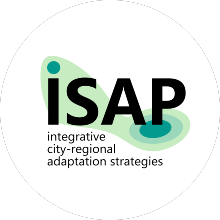What is ISAP?
For the model region of Stuttgart—as a polycentric, highly dense area with strong economic growth—adaptation to the effects of climate change is a key requirement for maintaining quality of life in the 179 cities and municipalities and the safety and competitiveness of the region as a whole. The region is already characterized by extreme summer heat stress and air hygiene problems. Heavy rainfall events have hit important infrastructure facilities several times. Compared to existing textual recommendations for adaptation in planning and qualitative testing instruments, the originality of the ISAP project lies in the development of a quantitative adaptation check, which includes indicators on adaptive capacities as well as costs and benefits of adaptation measures at the city-regional level. Also ground-breaking is the development of a city-regional hydrodynamic heavy rain risk map based on regional climate modelling.
Overall, the ISAP project aims to improve the planning basis and its application in decision-making processes in order to establish the use of climate adaptation measures as a self-evident and integrative part of spatial development planning. For this purpose, ISAP is developing a new, innovative city-regional online information and advice system together with the region and the city of Stuttgart. Firstly, the system includes precisely tailored city-regional information and analysis instruments for climate adaptation, such as climate data, vulnerabilities and adaptation needs, with a focus on the specific needs of users the model region. This will build on the “Regional Climate Atlas” that was originally published in 2008 and will be updated and further developed as part of ISAP. In addition to new climate information, data on future land use change and developments in social vulnerability will also be integrated into the information system in order to substantiate the need for adaptation. Secondly, based on this, strategies and tools for adaptation action, such as a quantitative adaptation check, indicators and criteria for adaptive capacities as well as extended cost-benefit methods, will be developed. New, integrated analysis and evaluation methods are applied. Also innovative is the dynamic perspective, i.e. the need for adaptation as well as the costs and benefits of measures are determined against the background of integrated scenarios of regional climate and land use change as well as changes in vulnerability. In addition to the region-wide testing, local focus areas will be used to determine the practicability of the new online information and advice tool. The tool will be analysed as to its user-friendliness and applicability for formal and informal planning instruments. The exchange with other regions (national and international) will ensure that the results can also be used in other regions. Overall, the work is based on the basic understanding that climate adaptation should not be processed as a solitary building block, but as an integral part of municipal, district or regional development planning.
ISAP is one of six model projects working within the framework of the Federal Ministry of Research, Technology and Space (BMFTR) funding measure “Regional Information on Climate Action” (RegIKlim) to improve the climate adaptation capacities at the level of regions and municipalities through digital instruments. The measure is part of the flagship initiative "Local climate and environmental models for cities and regions of the future" of the digital strategy as well as of the "Natürlich.Digital.Nachhaltig." action plan of the BMFTR.
Funding source:
Federal Ministry of Research, Technology and Space (BMFTR)
Project sponsor:
German Aerospace Center (DLR)
Duration:
01.08.2020 - 31.10.2023 (Phase 1)
01.11.2023 - 31.10.2026 (Phase 2)






